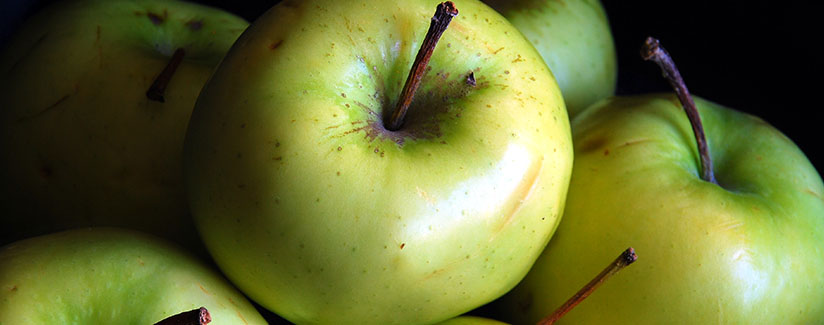
Is There Wax on Apples?
We recently posted information about washing fruits and vegetables in vinegar. But what about wax on fruits and vegetables? Through social media, we have noticed photos of apples covered in wax. Is that what it really is, and is it safe to eat? To answer these questions, we reached out to Dr. Joe Kemble, Professor of Horticulture at Auburn University.
Is there really wax on fruits and vegetables?
Dr. Kemble: “Yes – the apple is one of the fruits that produces its own wax. Many other fruits produce wax such as plums, pears, etc. The natural wax produced by the apple serves several vital roles. This natural wax:
- helps the apples resist moisture loss,
- enhances the fruit firmness, and
- slows down the natural degradation of the apples.
Remember, apples are alive even after they are picked and will continue to live, provided they have the sufficient resources and an acceptable environment. The waxy coating produced by the apple and found on its skin protects it. The waxy coating can appear milky sometimes, but if you rub it gently, you can actually get it to it shine.The natural wax on the fruit of the apple contains about fifty individual components belonging to at least half a dozen chemical groups. The major cyclic component of apple fruit wax is called ursolic acid and is highly water-repellent. Research has shown that ursolic acid is capable of inhibiting various types of cancer cells and can serve as a starting material for synthesis of more potent bioactive compounds such as antitumor agents.”
Is additional wax added to fruits and vegetables?
Dr. Kemble: “In some situations, additional food-grade wax is added to the outside of the produce to augment the fruit’s natural waxy covering. This is done, for example, with cucumbers. In some root crops, like rutabagas and turnips, food-grade wax is added to the outside to increase shelf-life. Food-grade wax is safe to eat.
As mentioned earlier, apples do produce their own waxy coating. Additional wax can be added, but it depends on the maturity of the apple after harvest and variety. Waxes are either derived from natural or synthetic processes, but all are organic compounds.
For the science geek like myself, natural waxes are typically esters (just a way organic chemists use to classify compounds) of fatty acids and long-chain alcohols. Plants and animals can produce their own waxes and several of these natural waxes are considered “food-grade waxes” because they are safe for use on food intended for human consumption. Shellac, for example, is a commonly found natural wax which is derived from the female Lac bug. Carnauba wax, as another example, is also a natural wax but is produced by the leaves of the Carnauba palm. Both of these waxes are “food-grade waxes” and have been used on food for decades. The FDA has labeled both of these waxes safe for human consumption. Both of these natural waxes are complex mixtures and contain some of the same components found in the wax of an apple.”
You said it’s safe to eat the wax. How do we know it’s safe?
Dr. Kemble: “One point to note about waxes is that they are indigestible by humans. Humans do not have the ability to break down waxes and absorb their various components. Waxes simply pass through our digestive systems untouched. There are many more types of natural waxes out there produced by various plants and animals such as beeswax produced by honeybees, bayberry wax produced from the surface wax of the fruits of the bayberry bush, soy wax produced from soybean oil, etc. Depending on its intended use, different types of natural and synthetic waxes can be mixed together in order to provide the exact properties that someone requires in a wax. Grafting wax, which is primarily beeswax plus a number of other components, is designed to soften significantly when worked with your hand by adding a number of components to beeswax. Beeswax alone is stiff and not workable at 98 degrees.”
So why add wax if apples produce it naturally?
Dr. Kemble: “An apple with a good waxy coating will store better than one with a partial waxy coating or no waxy coating at all. Another interesting aspect of waxy coatings and apples is that growers can take advantage of the storage ability of many apple varieties because of this waxy coating. You might have heard the term “controlled-atmosphere storage” and wondered about it. Apples can remain in controlled-atmosphere (CA) storage for a long period simply by reducing the oxygen levels in storage. Some apples such as Fuji and Delicious (red and yellow) can be stored up to one year in CA storage. CA storage does not involve adding any chemicals – just modifying the environment by lowering the oxygen levels and tightly controlling the environment around the apple. The apple must have its waxy coating intact in order to benefit from CA storage.”
Will vinegar help get the wax off?
Dr. Kemble: “Yes, vinegar will degrade the waxy coating and, if it is left in contact for a long period, it will remove all of the wax. The wax, however, serves as a protection system for the fruit/vegetable. This waxy coating helps to prevent moisture loss and it provides a physical barrier preventing some microorganisms from entering the fruit. The degree or extent of this waxy coating depends on the variety, maturity at harvest, and storage condition.”
For more information about controlled atmosphere storage and wax on apples, Dr. Joe Kemble said to visit Washington State and The Best Apples.
“Apples” by DuesXFloridamizo is licensed under CC BY.


























